

The UX of Learning. While many desk-shackled students may wish they were napping rather than enduring yet another monotonous lecture, learning is by no means confined within the classroom.
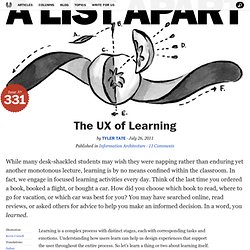
In fact, we engage in focused learning activities every day. Think of the last time you ordered a book, booked a flight, or bought a car. How did you choose which book to read, where to go for vacation, or which car was best for you? You may have searched online, read reviews, or asked others for advice to help you make an informed decision.
In a word, you learned. Learning is a complex process with distinct stages, each with corresponding tasks and emotions. A hierarchy of learning#section1 According to Benjamin Bloom’s landmark 1956 study, we can classify learning in a hierarchy of six levels, where each level forms the foundation for the next. Fig. 1: Bloom’s Taxonomy of Learning. Downloads/dtse-chapter2.pdf. You Can Get There From Here: Websites for Learners. Like many modern parents, I probably tell my kids to “go look it up online” about a hundred times a week.
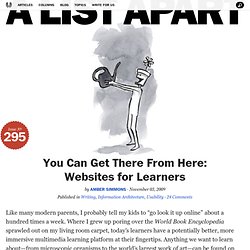
Where I grew up poring over the World Book Encyclopedia sprawled out on my living room carpet, today’s learners have a potentially better, more immersive multimedia learning platform at their fingertips. Anything we want to learn about—from microscopic organisms to the world’s largest work of art—can be found on the web. The internet is the greatest contribution to learning since the printing press. At least, that’s the dream; the reality is a little less sparkly. Most websites are not learner-friendly. As an industry, we haven’t done our best to make our content-rich websites suitable for learning and exploration.
Narrative#section1. Some Differences Between Experts and Novices. Harrisburg Presentation Resources Here are some resources from my presentation in Harrisburg.

Defining and Exploring Gamification from Karl Kapp Here is some additional information. Articles and Blog Entries of Interest 8 Types of Stories to Effect Change Storytelling and Instructional Design Eight Game Elements to Make Learning More Intriguing Games, Gamification and the Quest for Learner Engagement Gamification, […] Continue Reading → Teaching Expert Learners. Harrisburg Presentation Resources Here are some resources from my presentation in Harrisburg.
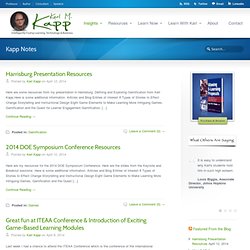
Defining and Exploring Gamification from Karl Kapp Here is some additional information. Articles and Blog Entries of Interest 8 Types of Stories to Effect Change Storytelling and Instructional Design Eight Game Elements to Make Learning More Intriguing Games, Gamification and the Quest for Learner Engagement Gamification, […] Continue Reading → 2014 DOE Symposium Conference Resources Here are my resources for the 2014 DOE Symposium Conference. Continue Reading → Great fun at ITEAA Conference & Introduction of Exciting Game-Based Learning Modules Last week I had a chance to attend the ITEAA Conference which is the conference of the International Technology and Engineering Educators Association.
Continue Reading → Instructional Games and Narrative. Corporate Training & e-Learning Blog: The 10 Biggest Breakthroughs in the Science in Learning. The 10 Biggest Breakthroughs in the Science in Learning When it comes to human organs, none is quite so mysterious as the brain.

For centuries, humans have had numerous misconceptions and misunderstandings about how the organ works, grows, and shapes our ability to learn and develop. While we still have a long way to go before we truly unravel all the mysteries the brain has to offer, scientists have been making some major breakthroughs that have gone a long way in explaining both how the brain functions and how we use it to organize, recall, and acquire new information. Here, we list just a few of the biggest and most impactful of these breakthroughs that have contributed to our understanding of the science of learning.More information doesn’t mean more learning.
The brain is equipped to tackle a pretty hefty load of information and sensory input, but there is a point at which the brain becomes overwhelmed, an effect scientists call cognitive overload. Going From One-Size-Fits-All Education, To One-Size-Fits-One. In June of 2009, after Michael Jackson died, I decided it was time to learn how to moonwalk.

I went to YouTube and found the “How to Moonwalk” video with the most hits, a simple 2:15 minute homemade job by Montreal DJ AngeDeLumiere. The video proved to be a lesson not only in a dance step but in transformative pedagogy. Ange begins by showing us what we think is the way to do the moonwalk. He’s right. That is exactly how I used to think it was done. Alvin Toffler calls this method of instruction “unlearning.” Ange’s video is a great model of teaching and a great metaphor for the kind of educational change we need to embrace right now. But if learning is the issue--and especially learning in an age of information abundance--then we have to unlearn that old model. Take the example of learning a new sport. Whenever I speak before large gatherings of corporate trainers, they tell me they can recruit anyone now, in this economy; the very best students from the very best universities. The Next Step for Learning: Practical Contextualization by Clark N. Quinn.
“Context-sensitive delivery is already here, but the learning opportunities are just nascent.
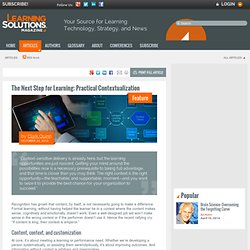
Getting your mind around the possibilities now is a necessary prerequisite to taking full advantage, and that time is closer than you may think. The right context is the right opportunity—the teachable, and supportable, moment—and you want to seize it to provide the best chance for your organization to succeed.” Learning Design. Organizations that have started implementing elearning typically find that it's not as effective as they intended.
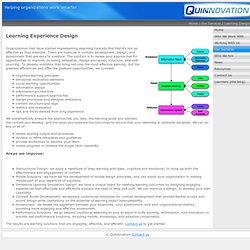
There are nuances in content development, design, and assessment that are easy to overlook. The solution is to review your approaches for opportunities to improve, including templates, design processes, structure, and skill-sourcing. To develop solutions that bring not only the most effective learning, but the greatest efficiencies and offer the greatest opportunities, we consider:cognitive learning principlesemotional motivation elementssocial learning opportunitiesinformation designinformation architectureperformance support approachesdesign processes and designer limitationscontent structure and tagsmetrics and evaluationtips and tricks derived from long experienceWe systematically analyze the approaches you take, the learning goals you address, the content you develop, and the ways you evaluate the outcomes to ensure that your elearning is optimally designed.
Designing Backward and Forward. So I began thinking about performance experience design as a way to keep us focused on designing solutions to performance needs in the organization.
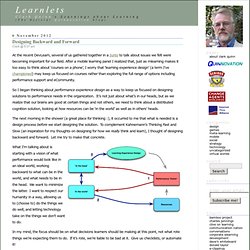
It’s not just about what’s in our heads, but as we realize that our brains are good at certain things and not others, we need to think about a distributed cognition solution, looking at how resources can be ‘in the world’ as well as in others’ heads. The next morning in the shower (a great place for thinking :), it occurred to me that what is needed is a design process before we start designing the solution. Work environment design for learning. Catherine Lombardozzi writes, in Time for an Evolution:
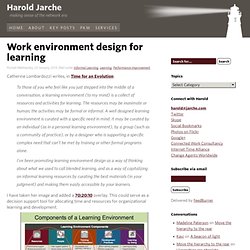
What To Do If They Want "Awareness" What To Do If They Want "Awareness" Posted by Allen Interactions on Wed, Dec 12, 2012 by Cathy Moore, guest blogger, @CatMoore We are delighted to have Cathy Moore as a guest blogger this week. She is an international thought leader dedicated to saving the world from boring instruction. She’s a passionate advocate for improving business performance by respecting and deeply challenging learners. "We just need everyone to be aware of the policy," your client says. Which of the following should you do next?
Creating e-Learning That Makes a Difference. Makin' It Real: Creating Authentic Learning Experiences. Tp525-8-2. New Workplace Learning (2013)